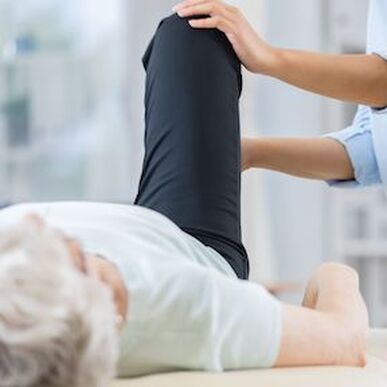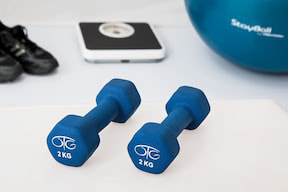|
Developing a stretching and range of motion exercise routine can improve your flexibility and reduce pain and stiffness. As ALS progresses and muscles weaken, less movement each day can lead to tightness, stiff joints, pain, and discomfort. This can affect your mobility, flexibility, and ability to complete daily activities. You can reduce this joint stiffness and maintain greater flexibility by stretching and doing range of motion (ROM) exercises, which are slow movements that target specific parts of the body such as your neck, shoulders, elbows, wrists, fingers, hamstrings, knees, calves, and ankles. |
|
Developing Your Stretching and Range of Motion Routine
It is important to create a stretching and range of motion exercise plan that is tailored to your specific needs. Ideally, you will find someone with ALS experience, like the physical or occupational therapist at your ALS clinic or home health agency, who can develop a custom routine and teach you and your caregiver how to properly do each exercise.
You can stretch and do ROM exercises on your own or with the help of a caregiver. Some people find that even if they are capable of doing them on their own, they feel a greater benefit when someone else is assisting so they can relax throughout. If you can do the exercises on your own but are getting overly fatigued, you may also want to ask for assistance.
You can stretch and do ROM exercises on your own or with the help of a caregiver. Some people find that even if they are capable of doing them on their own, they feel a greater benefit when someone else is assisting so they can relax throughout. If you can do the exercises on your own but are getting overly fatigued, you may also want to ask for assistance.
|
|
|
|
|
If you cannot do parts of the movements or stretches on your own, a caregiver or therapist can assist as needed. If you are unable to assist with the movements, your caregiver or therapist can do them for you. When possible, sit or lie down to conserve energy while doing your exercises.
Keeping in mind that everyone’s individual plans will be different, here are some general guidelines for doing range of motion exercises:
You will get maximum benefit if you do these exercises once or twice every day (or as prescribed). Try to find the best time to integrate them into your daily routine and set aside enough time so that you don’t feel rushed. Some people find that breaking their exercises up into a few short sessions throughout the day works better than doing them all at once. If you do this, complete all the repetitions for each stretch or exercise in the same session.
If something changes and your current exercise plan no longer works for you, ask your physical or occupational therapist to modify your plan.
Keeping in mind that everyone’s individual plans will be different, here are some general guidelines for doing range of motion exercises:
- Stretches and ROM exercises should be slow, steady, and gentle.
- Do not force movements or push past the point of resistance.
- Back off if you feel pain, discomfort, or fatigue.
- Make sure that you can breathe comfortably throughout.
- If you cannot complete the full routine, start with a few repetitions and build up from there.
- When stretching, slowly move to the point of resistance and hold as advised.
You will get maximum benefit if you do these exercises once or twice every day (or as prescribed). Try to find the best time to integrate them into your daily routine and set aside enough time so that you don’t feel rushed. Some people find that breaking their exercises up into a few short sessions throughout the day works better than doing them all at once. If you do this, complete all the repetitions for each stretch or exercise in the same session.
If something changes and your current exercise plan no longer works for you, ask your physical or occupational therapist to modify your plan.
A Note About ExerciseAn ALS diagnosis will change the way you’ll need to approach exercise. Overexertion can drain your energy and weaken your muscles. Learn more about exercise and ALS.
|
How Caregivers Can Help
|
If you are a family caregiver or a paid caregiver, you can play an important role in helping the person living with ALS feel less pain and discomfort by assisting with stretching and range of motion exercises. Ideally, the physical or occupational therapist will show you how to perform or assist with each movement and stretch. You can also ask to film the professional demonstrating each exercise so you can refer back to it as needed.
In general, you will want to support the weight of the involved body part, move it slowly through a gentle range of motion up to the point of resistance, and back off at any sign of pain or discomfort. Allow the person to actively participate as much as they would like. |
|
Lower Body Stretching and Range of Motion Exercises
Preserving range of motion in the lower body is particularly important for mobility. Stretching tight calves and Achilles tendons and improving ankle flexibility may help improve walking and transferring and lessen foot drop.
Common lower body exercises include the runner stretch, hamstring stretch, hip and knee flexion, and ankle flexion. Watch the following videos to learn more.
Common lower body exercises include the runner stretch, hamstring stretch, hip and knee flexion, and ankle flexion. Watch the following videos to learn more.
|
|
|
Upper Body Stretching and Range of Motion Exercises
Preserving range of motion in the upper body can help you continue to perform daily activities. Shoulder stiffness from lack of movement is common and can be very painful when doing things like dressing and transferring. Curled fingers and thumbs can prevent you from grasping and doing a variety of everyday tasks.
Upper body range of motion exercises can improve flexibility and function in your neck, shoulders, elbows, wrists, hands, fingers, and thumbs. Watch the following videos to learn more.
Upper body range of motion exercises can improve flexibility and function in your neck, shoulders, elbows, wrists, hands, fingers, and thumbs. Watch the following videos to learn more.
|
|
|






